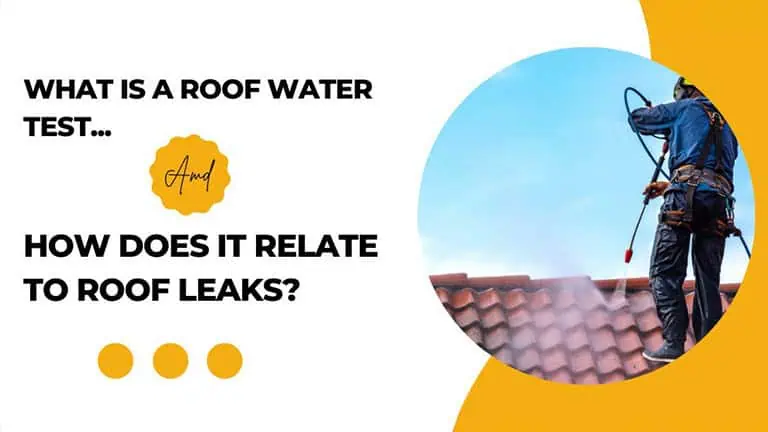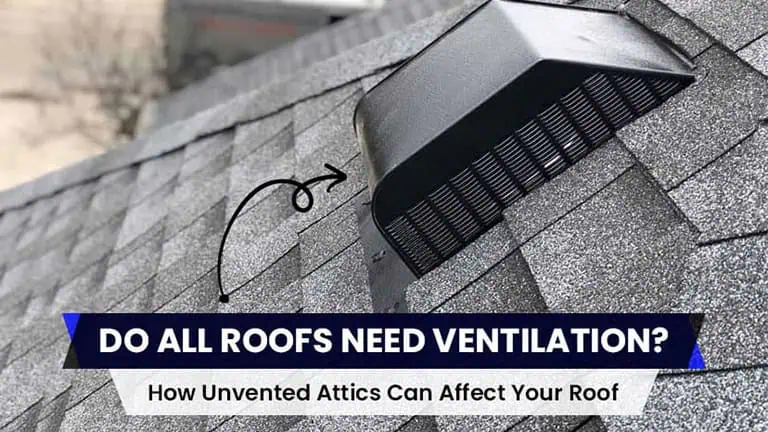
What’s a Roof Water Test?
If you’ve ever been unfortunate enough to feel the wet kiss of a leaky roof on your head, you already know how pervasive they are and how bad they can get if left unattended. What might begin as a discolored spot can quickly evolve into a real mess without proper intervention.
And one way roofing contractors find the source of pesky leaks is with a roof water test. Roofers use this test to identify the most common sources of leaks, such as damaged shingles, deteriorated flashing, or improper or failing seals. It’s typically performed by spraying water on the roof’s surface or in specific areas where leaks might be suspected. The water is applied at a controlled rate and observed to see if it penetrates any roofing materials and enters the interior space.
If you’re a home or business owner experiencing the woes of a leaky roof, you’ll want to keep reading for valuable information on roof water tests, how to find leaks and the best course of action for your needs and budget. Stick around; you might learn something new!
How the Water Test Works
Now that we’ve given you a brief overview of how a water test is performed, let’s break down the steps that roofing contractors take to check for roof leaks:
1. Interior Inspection
The first step in identifying a roof leak is often an interior inspection. Roofing contractors in Greenville will examine the affected areas inside the building, looking for water stains, damp spots, or signs of water damage on the ceilings, walls, or insulation. This step helps them pinpoint the general location of the leak.
2. Isolating the Suspected Area
Once they’ve determined the general area of concern, roofing contractors work to isolate the suspected region. This may involve moving furniture, lifting floor coverings, or accessing crawl spaces or attics to get a closer look. They aim to narrow down the source of the leak to a specific point on the roof.
3. Controlled Water Application
To confirm the source of the leak and assess its severity, roofers perform a controlled water application. They mimic rain or moisture by using a garden hose to gently spray water on the roof’s surface, focusing on the area they suspect to be the source of the leak. This controlled test helps them identify the exact point where water penetration occurs.
4. Observing Water Entry
During the controlled water application, roofing contractors closely observe how the water behaves on the roof. They pay attention to any signs of water entry, such as dripping, staining, or visible dampness. This allows them to confirm the source of the leak and evaluate the extent of the damage.
5. Adjustment and Confirmation
In some cases, roofing contractors may need to slightly adjust their water application to ensure the leak’s source is correctly identified. They might vary the water flow or the application angle to confirm the results. This step ensures precision in pinpointing the leak.
6. Repairs
Once the exact location of the leak is confirmed, roofing contractors can proceed with the necessary roof leak repair. This may involve patching damaged roofing materials, replacing worn-out shingles, or addressing issues with flashing gutters, or seals around roof penetrations. The goal is to restore the roof’s integrity and prevent future leaks.
How To Check for Leaks
While water tests are an effective way to search for potential leaks, they’re often used as a last resort when all other avenues have failed. As a homeowner, your first approach will be to perform a visual inspection. Whether handled by yourself or professional roofers, this is your first way of finding smaller issues before they become major problems.
You’ll start by performing an interior inspection, checking for any indicators of water penetration. If found, you’ll want to trace the source of the stain back to the corresponding roof area and perform the needed roof repairs.
If there are no obvious signs of water penetration, your next step will be to check the flashing. Roof flashing is a crucial component that protects chimneys, vents, and skylights, but it can become loose or fail over time. Flashing issues will need to be corrected immediately.
From there, you’ll want to check your gutters and downspouts for blockages. Clogged or damaged gutters can cause water to overflow and potentially enter your home.
And, finally, if you’ve failed to find the source of your issues, it’s never too late to call in professional roof repair services. These roofing experts will have the tools and skills to inspect your roof quickly, find the leak source, and provide quick and efficient roof repairs.
Common Causes of Roof Leaks
As one can imagine, water can penetrate a roof in several ways. But, understanding some of the common causes of leaks can give you an idea of what to look for and where to start when it comes to roof repair.
One of the primary culprits is damaged or missing shingles. Over time, shingles can deteriorate due to exposure to the elements, UV rays, and general wear and tear. And when these shingles become damaged, water can easily seep in. Another issue mentioned previously is failing flashing. Flashing seals vent pipes, chimneys, and skylights but can easily become damaged by high winds, debris, or extensive rainfall.
Additionally, if you live in colder climates, snow accumulation can cause melted snow to form ice dams, leading to pooling water that can penetrate your roofing.
And finally, one of the most comprehensive contributors to roof leaks is storm and hail damage. High winds, hailstones, and storm debris can wreak havoc on rooftops, knocking loose shingles, damaging flashing, and creating access for water to seep into your home.
How to Fix Roof Leaks
Although some roofs are built to last for years, keeping them in tip-top shape is the key to preventing damage from leaks. Staying vigilant, knowing what to look for, and knowing when to call professional roof repair services are key.
This is because there are many different types of roofs, and maintaining them can vary based on the materials and style of the building. For example, flat roof leak repairs might not use the same methods as metal roof leak repairs. And knowing how to approach each one is always best left to the experts.
So, if in doubt, call licensed roofing contractors with experience who can do the job right the first time.
Statewide Roofing Specialist is Here for Your Roofing Needs
Whether you’re in need of emergency roof repairs or considering a full roof replacement, Statewide has covered you with expert guidance, high-quality materials, and affordable options for any budget. We’re fully certified, licensed, and ready to tackle North Carolina’s biggest roofing problems. Give us a call today at (336) 480-1824 to speak with one of our roofing experts about your concerns. We provide comprehensive emergency roof leak repair services, free inspections, and will offer you a plan for repairs that will keep the roof over your head in pristine condition, through all seasons. Contact us today, and let us show you quality service that stands up to any weather.


